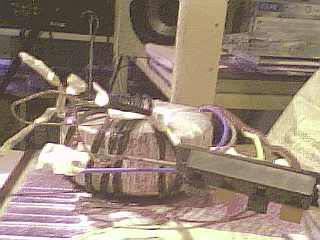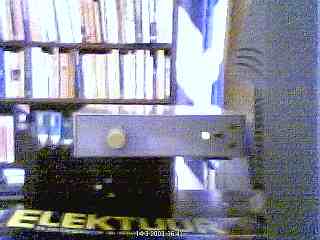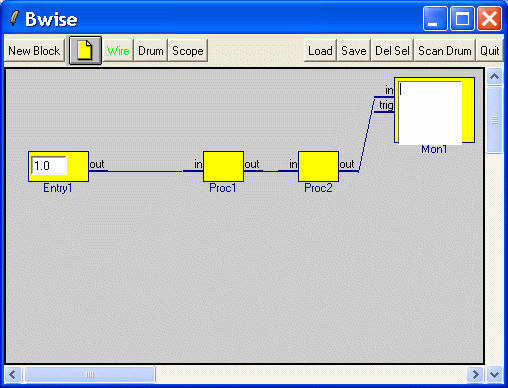Theo Verelst Local Diary Page 6
The same holds as for my tripod and other
diary pages: nothing on this page may be copied or changed and distributed
except that the page as a whole may be printed or otherwise transfered
in unchanged form, mentioning the original URL and global page
reference, and that holds for everyone on the globe and beyond, including
so called 'christians' and self-appointed 'Secret Services'.
Home (alt)
Tripod Home Local Diary list (Secure) Tripod Diary List
Previous Diary
Mar 14 2003, 16:14 PM

A photo I put on photo.net recently
Working at three things at more or less at the same time.
When that is possible that's not bad.
While I'm working at about three things at the time, excluding writing this
page, I though I'd put in a few notes, sort of after I provided a virus check,
which after longs months of internet server running still turns out fully
negative, which is reassuring.
I've tried a heavy toroid transformer to feed the 'sweet little' portbable
high Q amplifier into full serious hifi power, probably in about the 100W
range, good fun, that is, I first checked the capacitors for maximum voltage,
and then simply fed the AC input with a 6-12 amp, 25 V AC voltage, not regarding
the only about .75 mm2 lead and the moderate thick wall wart supply type connector.
But it worked wonderfully, lots more stable supply, higher voltage, both
good for the amp quality, and of course loads of 'headroom'. Tried several
sources, worked fine, I used a heavy heat sink at some point which I placed
simply under the small aluminium case right under the amp chips, with the
thick part of the sink over the exact places where the chips connect to the
aluminum playing disco for a little while proved to not heat the whole machinery
even to the boiling point.
The 300 Watt toroids still seem to dim the light when switched on, I found
there are special fuses for it.
I made a 16 bit presettable counter/latch/3state output unit pcb, with a
single 16 bit connector and LED's at the counter output, which should be good
to get a memory prepared for a (fast) Z80 DMA'd full of data from a PC for
instance.

Perspective is: connector (matchbox), toroïd transformer, CD circumference,
'bookshelf' speaker

The little ampon top of the heat sink

On the bottom: the wires from the microprocessor boards getting
connected.
Does this all work? In certain ways it is not bad, I'm not at all installing
and using all possibilities yet, and currectly focus on imo important subjects,
like probably making a good set of pages about making various things, how
the is designed and how they work.
Bwise is in the month

A animation which indicates how bwise activates blocks on a row I put on
the tcl 'wiki'. I'll make some more pages there, I'm sure.
The flip flop
Is that a dance?
It's an interesting circuit, essential for digital designers, which many
maybe self acclaimed computer experts do not know much about or understand,
and which would tilt a millions soaking alledgedly 'correct by design' design
system I was forced to work with in the past, because it makes the all important
link between a funcional unit, that is a (possibly black) block which simply
translates its input values in a short, negiligable time to a predefined
matching output value, and something which has memory.
 Flip Flop circuit made in bwise, the yellow blocks are programmed to
act as logical NAND ports.
Flip Flop circuit made in bwise, the yellow blocks are programmed to
act as logical NAND ports.
A flip flop has two stable states, which can exist without error for sustained
periods of time, simply because all blocks in the circuit are satisfied with
the inputs they receive and stay with their output all the time. There are
also 'transitory states' which are transient, they exist just for a while,
and then resolve into a stable state.
As a sideremark for now, I made the procs which contain nand circuits automatically,
by using another block, which generates ands on request. This is now that
generator block was made:
set n 1
newproc "newproc \"set proc\${genproc.n}.q \\\[expr !(\\\${proc\${genproc.n}.a} && \\\${proc\${genproc.n}.b})\\\]\" proc\${genproc.n} {a b} q ;set genproc.nlast \${genproc.n}" genproc n nlast
The following image shows the result of connecting the generator block with
a incrementor block (add one, for indexing), into a circular graph which
is run by using the 'funprop' menu on the genproc block, which sets it up
for the next invokation, and makes a new procn and function block.Did we
just make a (super) class? Not realy, it's just a code generator with well
defined parametric results. Which is probably all the better.

Part of the image was a 'overlay' TV image, which might let an overlay window
shine through when its in browser. In fact I just found out it doesn't work
on this jpeg version. The info windows show what the procedures contain which
are block functions for genproc and the incrementor.
Light distribution

The above is an image coming from POV-ray, a graphics package which can be
freely downloaded, probably for various platforms, try google or whichever
is your favorite search engine.
It is made from nothing but a graphics description in a computer text file,
and is rendered by the program which in this case simulates the light coming
from the white place on the ceiling, and bouncing of the walls and floor
and objects.
Takes quite a while to compute a large image.





 Flip Flop circuit made in bwise, the yellow blocks are programmed to
act as logical NAND ports.
Flip Flop circuit made in bwise, the yellow blocks are programmed to
act as logical NAND ports.
